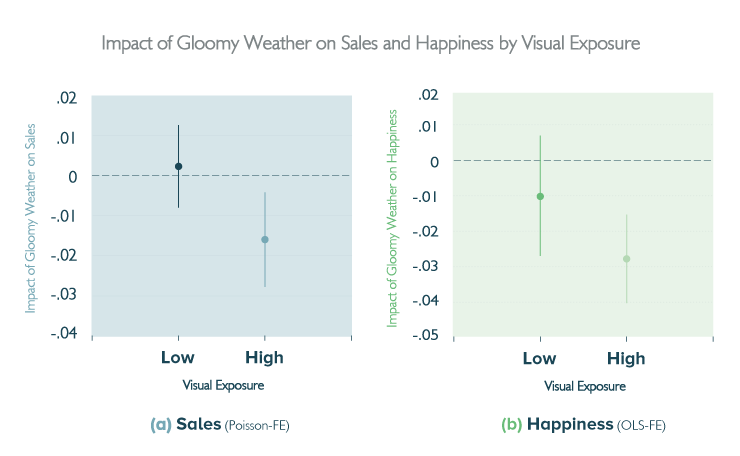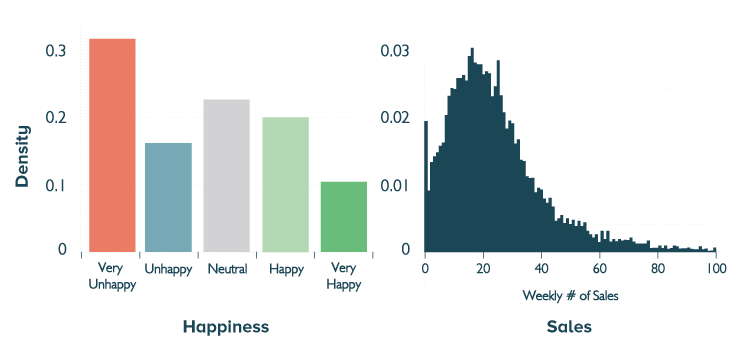Does employee happiness impact productivity? Yes – and we’ve got proof!
Does the happiness of your employees impact their productivity? This question has been asked by thousands of business leaders and academics over the decades. But it’s the recent work of three diligent researchers – Bellet, De Neve and Ward – that has caught our attention the most.
You see, in 2020, these three academic heroes set up a massive research project with one of the UK’s biggest employers – designed to answer the question of whether or not employee happiness impacts productivity. And the short answer? Yes – yes it does!
But as with most things, the answer deserves far more than a simple “yes” or “no”. In fact, the full published paper is 59 pages long, and delivers some pretty killer conclusions that are actually super helpful to any modern business leader wanting to crank things up a gear.
Now, if you’re a fan of raw academic research, then you can find the full 59-page report right here. Of course, if you’d rather spend 10 minutes grabbing the key takeaways, then you’ll be pleased to know that we’ve already digested the full paper for you. And we’ve written our own bite-sized takeaways of the methodologies, the challenges, and importantly, the big business conclusions.
So if you’re ready to learn something? Then grab a coffee – and let’s dive right in.
“Hello, would you like to switch your internet service provider?”
The study took place across 11 BT call centers across mainland UK. Why? Well for starters, BT (British Telecom) is one of the UK’s largest employers, which gave the team a generous sample size of 1,793 busy call center workers. Secondly, the geographical coverage was excellent – with office locations spreading from Dundee in Scotland, to Truro near Cornwall.
But perhaps the most significant reason for studying this huge group of telesales executives, is because telesales workers have perhaps the most measured and monitored productivity outputs than any other profession. And this productivity reporting tends to consist of detailed, measurable and data-driven metrics – which are great for academic study, due to how easily they can be placed on a scale, and correlated with other data points.
In this case, the researchers were recording productivity outputs such as:
– Number of sales per week
– Average time spent per phone call
– Number of calls made per day
– Ratio of calls-to-sales (conversion rate)
– Attendance and break-taking
With such huge quantities of operational data being churned out by almost 2,000 call center workers, you can perhaps see why we were so interested in what this study had to say about the impact of employee happiness on productivity.
But can we actually measure happiness?
Quite frankly, we can’t. Not very consistently, anyway.
Measuring happiness is such a difficult challenge to contend with in any academic study. You see, if you rely purely on self-assessment, then you’re subjecting your study to the different interpretations of “happiness”. And of course, if you rely on external observation then you’re highly unlikely to determine how a person is really feeling – not with any consistent degree of accuracy, anyway.
The way Bellet, De Neve and Ward approached this, was to collect a self-assessment score from each employee – but to also combine this with something called an “affective condition”.
An affective condition is an objective environmental factor known to have a strong link to something we’re trying to measure – in this case, happiness. This affective condition can then serve as a consistent proxy link when comparing other human behaviors, such as performance or productivity.
Now, this might sound a little “out of the box”. But actually, affective conditions have been proven time and again to be very good at indicating human behavior – even beyond productivity. For example, lab experiments have shown that affective conditions can impact things like time preferences or reciprocity. And according to Capra (2004), affective states even influence the way people behave in ultimatum scenarios, or “trust games” – Squid Game, anybody?
Nice weather… for ducks
In our case, the affective condition used by the research team was a very British condition indeed – the state of the weather outside.
The UK is widely known for its inconsistent weather patterns, and its ability to be bright and sunny in one region, while cold and snowy in another. And with access to 11 different office locations stretching from Scotland to Cornwall, the researchers concluded that exposure to gloomy weather consistently led to lower happiness scores. In fact, by reviewing the window positioning at each location, they even found that the greater the exposure to the weather, the bigger the impact on the mood.

And so, using a combination of self-assessment, weather conditions, weather exposure, and a metric ton of productivity data, Bellet De Neve and Ward were able to very effectively compare employee output with mood levels, in order to find a number of very interesting correlations between happiness and performance.
OK, so what conclusions did this study produce?
In short, happier employees are far more productive. The study reports that employee happiness had an average marginal effect of 3 additional sales per week – which, with a baseline of 25, is a pretty good increase.
This graph from the research paper shows how tight the correlation is between happiness and sales:

Of course, while it’s great to learn that happier employees produce more sales, this doesn’t really tell us why this is happening – something the researchers were also keen to find out.
They came up with three possible explanations for the effect of happiness on sales:
- Happier employees might be organising their time better
- Happier employees might be working faster (taking more calls per hour)
- Happier employees might be making better quality calls (better conversion rates)
There was evidence for all three of these in the paper. For example, workers did adhere more closely to their workflow, and they did make more calls per hour. But the most compelling channel was, by far, the third – the fact that employees were simply having better quality conversations with customers, and therefore achieving a much stronger sales-per-call ratio.
How can we know this? Well, because while conversion rates improved, call length was largely unaffected. And even though happier employees did make marginally more calls per hour, the average time they spent with each customer stayed the same. In other words, workers weren’t simply rushing customers through conversations – instead, they were having better quality conversations, and wasting less time between calls.
But doesn’t more sales equal more churn?
If you’re a cynical business strategist, then you might argue that cranking out higher volumes of sales does not necessarily equal more profit. Indeed, one of the challenges the researchers faced during this project was the idea that even if happier workers seem able to extract more sales from customers, this may come at the cost of lower customer satisfaction.
And of course, if customers are less satisfied, they are more likely to end their service early – leading to higher churn rates, which is an expensive problem, especially for subscription-based business models.
The good news is that the researchers were able to account for this, by compiling customer satisfaction scores into their research methodology. And as you might have guessed, the data showed that employee happiness actually increases customer satisfaction – meaning that not only do happier employees bring in more customers, but that those customers are more likely to stick around.
There are some things that happiness doesn’t affect
There were a few things that you might expect happiness to affect, to which this study simply shrugs its shoulders and says “no.”
We’ve already mentioned that happiness had no noticeable impact on call length. But it also had no effect on:
– Sickness leave
– General attendance
– Overtime
– Length of breaks
We find this interesting, because employers are so often focused on trying to crack the whip with micro-managerial metrics like break times. But this study shows that you can make significant productivity gains without any of these other metrics ever-changing – all you have to do is make employees happier!
In conclusion?
The link between employee wellbeing and performance has a long – and sometimes divisive – history. But academic studies continue to prove that better mood states seem to improve cognitive function, as well as the ability for workers to remain focused on their daily tasks.
For example, the work of Estrada et al (1997) shows that positive mood states support better information processing, while Isen et al (1987) identified how happiness improves creative problem-solving. And on the flip side? Killingsworth and Gilbert (2010) showed us how unhappy people are more easily distracted – the list goes on.
Read more: Five studies showing how employee happiness and business performance go hand in hand
And now, we have the excellent work of Bellet, De Neve and Ward (2020), showing that a happier workforce produces all sorts of metrics associated with productivity – not only in the form of more efficient task management, but also in the form of better conversion rates with customers, and a higher customer satisfaction rate to boot!
So the next time you are tempted to bark your disapproval at somebody’s lack of results, then consider that improving their environment may have far better results.
Huge thanks to the authors of this study:
– Clément Bellet, Assistant Professor at Erasmus School of Economics
– Jan-Emmanuel De Neve, Director at University of Oxford’s Wellbeing Research Centre
– George Ward, of Massachusetts Institute of Technology


 The winning psychology of owning your mistakes and apologizing at work
The winning psychology of owning your mistakes and apologizing at work
 The invisible productivity factors
The invisible productivity factors
 How Machias Savings Bank improved employee satisfaction and increased commitment to company values
How Machias Savings Bank improved employee satisfaction and increased commitment to company values